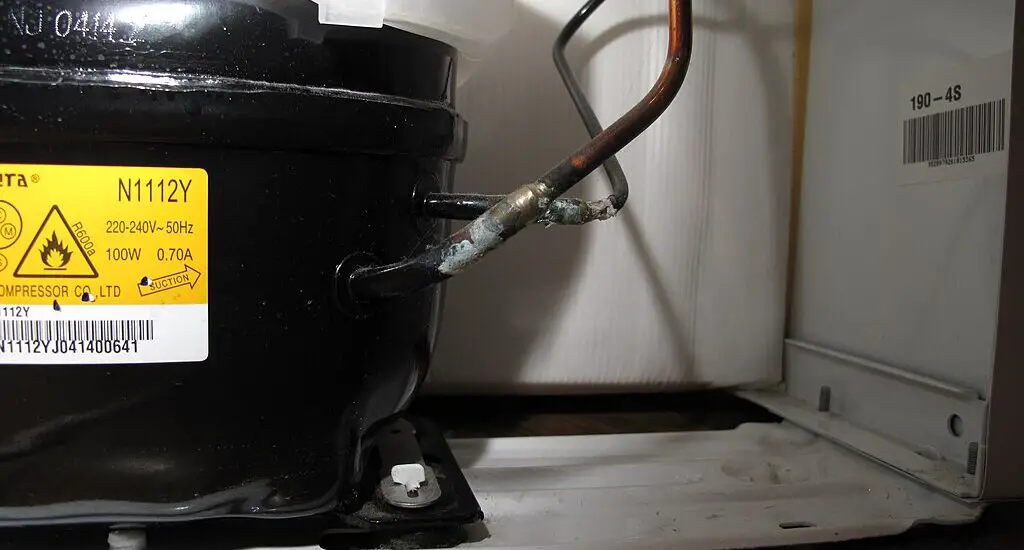What does a compressor do in a fridge? We’ll dissect the key role of the compressor and why it’s indispensable for a fridge’s function.

What Does a Compressor Do in a Fridge?
The refrigerator compressor is often likened to the heart of the refrigeration system, and for a good reason. Just as the heart pumps blood throughout our body, the compressor pumps refrigerant through the refrigerator. Specifically, it’s a motorized pump that plays a vital role in the circulation and compression of the refrigerant. Here’s how it works:
Intake: The compressor starts by drawing in the refrigerant, which is in a low-pressure gaseous state. This is the refrigerant that has absorbed heat from inside the fridge and hence has evaporated into a gas.
Compression: Once inside, the compressor pressurizes this gas. By compressing it, the molecules of the refrigerant are pushed closer together, resulting in a rise in its temperature and pressure.
Output: The now high-pressure, high-temperature gas is pushed out of the compressor to the next phase of the cooling process.
Without the compressor’s ability to change the refrigerant’s state from a low-pressure gas to a high-pressure gas, the cooling cycle would not be initiated, rendering the refrigerator non-functional.
Why the Compressor is Crucial
The essence of refrigeration is all about heat transfer. We want to remove heat from a particular space (inside the fridge) and release it elsewhere (outside the fridge). The compressor is pivotal in this process for several reasons:
Heat Removal: The primary purpose of the compressor is to prepare the refrigerant so it can release heat. By compressing the refrigerant gas, it elevates its temperature higher than the room’s ambient temperature. This temperature difference is what facilitates the effective release of heat in the next stages.
Initiating the Cooling Cycle: The compressor sets the stage for the entire refrigeration cycle. Without compressing the refrigerant, the necessary conditions for cooling wouldn’t be met.
Efficiency: A well-maintained compressor ensures that the refrigerator operates efficiently. If the compressor is weak or malfunctioning, the fridge may struggle to maintain the desired temperature, leading to spoiled food and increased energy consumption.
Check out these other articles…
Which Type of Compressor is Best for Refrigerator? Revealed
Refrigerator Compressor Vacuum Pressure: Comprehensive Guide
Does a Refrigerator Have 2 Compressors? Unveiling the Truth
Do Refrigerators Have Two Compressors? Comprehensive Answer
5 Types of Refrigerator Compressor: Essential Knowledge
How Do I Know What Size Compressor I Need for My Refrigerator?
What Happens When a Fridge Compressor Fails? 4 Signs & Fixes
Understanding the Refrigeration Cycle
The refrigeration cycle is a continuous loop that keeps our food cool and preserved. The compressor is just one part, albeit a critical one, of this cycle. Let’s break down the cycle into its core stages:
Compression: As discussed earlier, the compressor takes in the low-pressure refrigerant gas and compresses it. This results in the gas heating up and becoming high-pressure.
Condensation: The hot, high-pressure gas then moves to the condenser coils, which are usually located on the back or underneath modern fridges. As the gas flows through these coils, it loses heat to the surrounding air and condenses into a liquid. This phase is why the back of your fridge feels warm; it’s releasing the heat extracted from the inside.
Expansion: This high-pressure liquid then travels through an expansion valve. The valve reduces the refrigerant’s pressure, causing its temperature to drop drastically. It then turns into a cold, low-pressure liquid-gas mixture.
Evaporation: Inside the fridge are the evaporator coils. The cold refrigerant flows through these coils and, in the process, absorbs heat from the fridge’s interior. As it absorbs this heat, it evaporates back into a gas.
Returning to the Compressor: The cycle is complete when the refrigerant, now a low-pressure gas once more, returns to the compressor, and the process starts again.
This cycle is a delicate balance of physics and engineering, ensuring that our perishables stay fresh and safe for consumption.